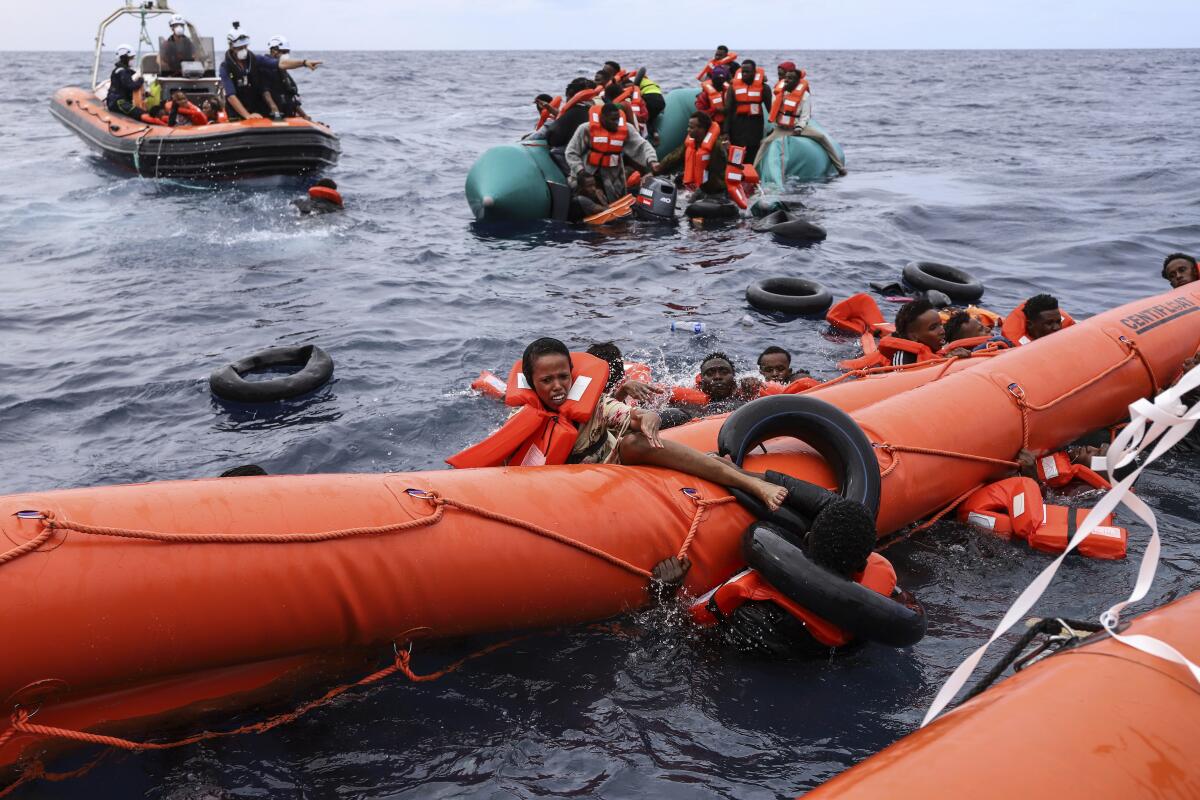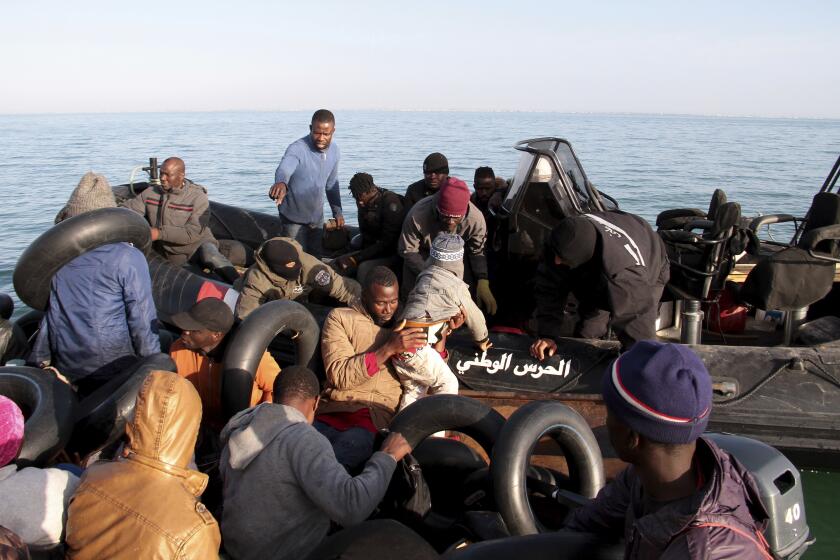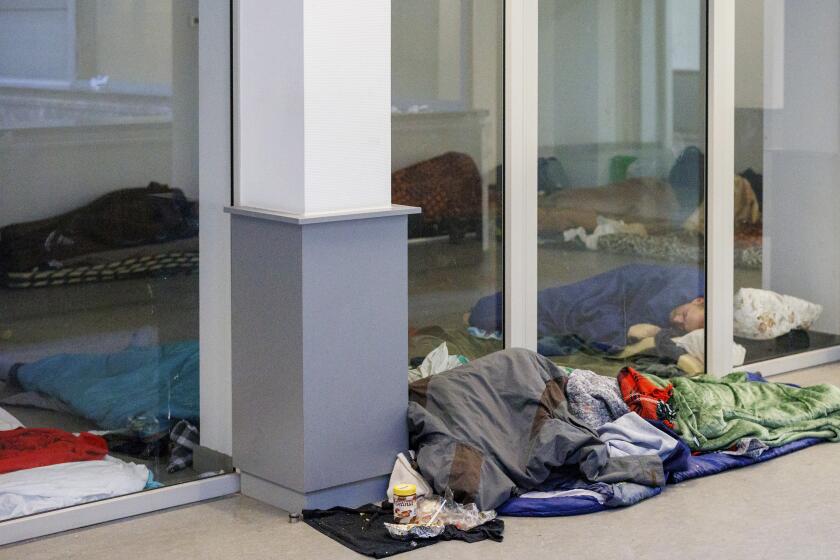European Union nations endorse sweeping reforms of migrant asylum system

- Share via
BRUSSELS — European Union nations endorsed sweeping reforms to the bloc’s failed asylum system on Tuesday as campaigning for Europe-wide elections next month gathers pace and migration is expected to be an important issue.
EU government ministers approved 10 legislative parts of the New Pact on Migration and Asylum. It lays out rules for the 27 member countries to handle people trying to enter without authorization, including how to screen them, establishing whether they qualify for protection and deporting them if they’re not allowed to stay.
Hungary and Poland, which have long opposed any obligation for countries to host migrants or pay for their upkeep, voted against the package but were unable to block it.
Mainstream political parties believe the pact resolves the issues that have divided member nations since well over 1 million migrants swept into Europe in 2015, most fleeing war in Syria and Iraq. They hope the system will weaken support for the far right in the June 6-9 elections.
However, the vast reform package will not take effect until 2026, bringing no immediate fix to an issue that has fueled one of the EU’s biggest political crises, dividing nations over who should take responsibility for migrants when they arrive and whether other countries should be obligated to help.
Migrants, mainly from sub-Saharan Africa, are undertaking perilous sea journeys to Europe in unprecedented numbers, sometimes with tragic results.
Critics say the pact will let nations detain migrants at borders and fingerprint children. They say it’s aimed at keeping people out and infringes on their right to claim asylum. Many fear it will result in more unscrupulous deals with poorer countries that people leave or cross to get to Europe.
Europe’s asylum laws have not been updated for about two decades. The system frayed and then fell apart in 2015. It was based on the premise that migrants should be processed, given asylum or deported in the country they first enter. Greece, Italy and Malta were left to shoulder most of the financial burden and deal with public discontent. Since then, the ID-check-free zone known as the Schengen Area has expanded to 27 countries, 23 of them EU members. It means that more than 400 million Europeans and visitors, including refugees, are able to move without showing travel documents.
Some 3.5 million migrants arrived legally in Europe in 2023. Around 1 million others were on EU territory without permission. Of the latter, most were people who entered normally via airports and ports with visas but didn’t go home when they expired. The pact applies to the remaining minority, estimated at around 300,000 migrants last year. They are people caught crossing an external EU border without permission, such as those reaching the shores of Greece, Italy or Spain via the Mediterranean Sea or Atlantic Ocean on smugglers’ boats.
Asylum applications in the European Union continued to rise in the first half of 2023, putting pressure on the bloc’s limited hosting capacities.
Under the plan, the country on whose territory people land will screen them at or near the border. This involves identity and other checks — including on children as young as 6. The information will be stored on a massive new database, Eurodac. This screening should determine whether a person might pose a health or security risk and their chances of being permitted to stay.
Generally, people fleeing conflict, persecution or violence qualify for asylum. Those looking for jobs are likely to be refused entry. Screening is mandatory and should take no longer than seven days, the plan says. That should lead to one of two things: an application for international protection, like asylum, or deportation to their home country.
People seeking asylum must apply in the EU nation they first enter and stay until the authorities there work out what country should handle their application. It could be that they have family, cultural or other links somewhere else, making it more logical for them to be moved.
The border procedure should be done in 12 weeks, including time for one legal appeal if their application is rejected, according to the plan. It could be extended by eight weeks in times of mass movements of people.
Procedures could be faster for applicants from countries whose citizens are not often granted asylum. Critics say this undermines asylum law because applicants should be assessed individually, not based on nationality. People would stay in “reception centers” while the assessments are done, with access to healthcare and education. Those rejected would receive a deportation order.
The deal, which drew criticism from rights groups over Egypt’s human rights record, was signed Sunday in Cairo.
To speed things up, a deportation order is supposed to be issued when an asylum request is refused. A new 12-week period is foreseen to complete this process. Authorities may detain people throughout. The EU’s border and coast guard agency would help organize joint deportation flights. Currently, fewer than 1 in 3 people who receive an order to leave are deported. This is often due to a lack of cooperation from the countries these people come from.
The new rules oblige countries to help an EU partner under migratory pressure. Support is mandatory, but flexible. Nations can relocate asylum applicants to their territory or choose some other form of assistance. This could be financial — a relocation is evaluated at 20,000 euros ($21,462) per person — technical or logistical. Members can also assume responsibility for deporting people from the partner country in trouble.
Two issues stand out: Will member countries ever fully enact the plan, and will the EU’s executive branch, the European Commission, enforce the new rules when it has chosen not to apply the ones already in place? The commission is due to present a Common Implementation Plan by June. It charts a path and timeline to get the pact working over the next two years, with targets that the EU and member countries should reach. Things could get off to a rocky start. Hungary, which has vehemently opposed the reforms, takes over the EU’s agenda-setting presidency for six months on July 1.
Cook writes for the Associated Press. AP journalist Renata Brito in Barcelona contributed to this report.
More to Read
Sign up for Essential California
The most important California stories and recommendations in your inbox every morning.
You may occasionally receive promotional content from the Los Angeles Times.













